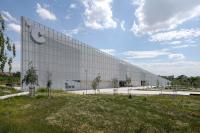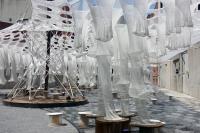Miami Residence
Miami, USA
This weekend getaway located in South Beach, Miami was designed for a young couple. They wanted a place that was very “Miami”. As a vacation home, the apartment is occupied for a few days at a time by the client and occasionally another guest. The renovation reflects the sporadic, temporary occupation, maximizes the ocean views, and creates a relaxed, changeable, informal, open atmosphere.
The existing space included two bedrooms, a living dining area, two and a half baths, and an entry foyer. The existing configuration separated the two bedrooms from the living room using two sheetrock walls coming off of the continuous curtain wall. This cut the view into three distinct zones so that the entire expansive view could not be seen from any location- instead you had a piece of the view in each room.
The view and proximity of the beach and ocean was the distinctive feature of the apartment. Our immediate idea was to free the whole width of the curtain wall to allow the entire expanse of windows to be seen at once. In addition we wanted to use materials and colors that suggest a continuation of the interior into the exterior, blurring the boundary between interior and exterior space.
In order to achieve this openness and also maintain the two enclosed bedrooms we designed two transformable “walls” that allow the windows (and views) to disengage from the bedroom walls.
These transformable wall units allow a dynamic, flexible way of configuring residential spaces- so that they can be easily reconfigured for different use groups or occasions. It allows the user to incorporate seldom used empty bedrooms into the main living space creating a much bigger living area and allowing the windows and views to be shared between spaces. This is a continuation of the “opening up” of living spaces which typically includes open kitchens living dining spaces: the “loft” model for residential arrangement.
These transformable “walls” were designed using materials and fabrication methods not commonly used in residential construction.
Moving Wall Unit- Because the guest room would only occasionally be used, we wanted the ability to fold it closed so that this space could become part of the living space. We created a combination storage closet and wall that hangs from the ceiling and slides out from the demising wall to create another room between the unit and the demising wall. By hanging the unit we maintained a clean floor and eliminated the possibility that the unit could tip over. The unit is operated by a crank (removable) driven mechanism. The crank handle turns internal gears which pull the 1,500lb unit along a steel link chain concealed in the three ceiling mounted steel tracks. The unit incorporates drawers, a hanging space and the door to the bedroom. The void in the center of the storage unit captures a Murphy Bed which is mounted to the demising wall. When in use, this void space provides additional hanging space and open floor area.
Pivot Wall- For the master bedroom we moved the entry to the bedroom against the windows, disengaging the wall and creating a 10 foot wide full-height pivoting wall. When the wall is open it allows the entire master bedroom window to be seen from the living room and from the master bedroom while also preventing anyone in the living spaces to look into the bed, study or dressing area. By rounding each corner of the wall (including the pivoting portion) we created a continuous flowing surface that starts in the entry and ends in this operable pivot wall- reinforcing the idea that this door is part of the wall and accentuating the depth of the apartment. It reinforces the idea of flow (visual or physical) toward the windows and view.
In the master bedroom we created two pieces of furniture which were designed in 3D on the computer and fabricated directly from these 3D models. By working directly in three dimensions we were able to precisely control the shape of each piece, working with the fabricator to resolved construction/installation issues.
The final pieces were computer milled from solid blocks of foam by Tom McGuire in North Carolina using our computer models. These foam shapes blocks were reinforced with steel and aluminum and covered in a lacquer finished, fiberglass skin. The assembly is similar to the construction of surfboards which we thought was appropriate on the beach particularly for our client who also enjoys surfing.
The desk was designed to cantilever from the wall and is anchored to a floor-to-ceiling steel column embedded in the millwork.
The bed shape came by lofting a flower shaped base with a rectangular bed . The underside and shape of this bed are important because they are reflected in the glossy resin floor. The bed is a loose piece of furniture that sits on the floor.
In order to further accentuate the view and to internalize the ocean and sand we used a custom Resin Floor with a subtle blue color and an embedded sand-like texture. The surface of the floor is smooth, slightly resilient and glossy to reflect the view and the sky outside.
Translucent and slightly iridescent curtains bring the blue into the apartment and allow varying levels of privacy/screening. The glossy white finish on the two transformable walls allows the reflections of the ocean views to dematerialize these perpendicular boundaries somewhat- joining the interior to the exterior.
In contrast to the dematerialized ocean view, the view towards the interior side of the apartment emphasizes solidity and material presence. The materials become less reflective and richer in texture and color. Dark natural rosewood paneling, warmer (red, orange and brown) colors, mosaics and flat finishes provide a solid physical anchor to the bright ephemeral finishes on the ocean side.











